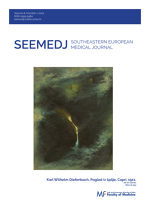Intimate Partner Violence Among Female Croatian University Students
DOI:
https://doi.org/10.26332/seemedj.v8i1.303Ključne riječi:
Croatia;, intimate partner violence; , prevention; , students; , universitySažetak
Aim: Intimate partner violence (IPV) among university student populations is an important public health challenge with persistent negative consequences. This study aimed to explore the prevalence of IPV among female Croatian university students and to investigate possible risk factors for its occurrence.
Methods: This cross-sectional questionnaire study was conducted on a convenient sample of undergraduate and graduate female university students at the University of Osijek in April 2015.
Results: The overall prevalence of all forms of IPV in the studied population was 64.3%. Physical violence was reported by 3.3%, psychological violence by 59.8%, controlling behavior or coercive control as a special form of psychological violence by 40.2%, sexual violence by 4.8%, and economic abuse by 9.6% of female students. Sexual violence and economic abuse were more frequent among graduate female students (p<0.001 and p=0.010, respectively). Female students who repeated the year of study were more frequently exposed to sexual violence (p=0.005). Overall IPV was more frequent among female students who studied within the field of humanities (p=0.045). Female students who studied within the field of humanities were more frequently exposed to physical violence, psychological violence, sexual violence, and economic abuse (p<0.001, p=0.006, p<0.001, and p=0.033, respectively).
Conclusion: IPV was highly prevalent among female Croatian university students and some sociodemographic and academic characteristics of those students seem to influence the observed prevalence of various IPV forms. Specific preventive programs adjusted to university settings are needed to successfully combat IPV in the studied population.
Preuzimanja
Objavljeno
Broj časopisa
Rubrika
Licenca
Autorska prava (c) 2025 Southeastern European Medical Journal

This work is licensed under a Kreativni Commons Attribution-NonCommercial-NoDerivatives 4.0 International License.



